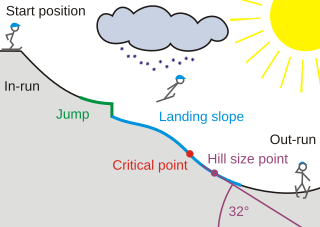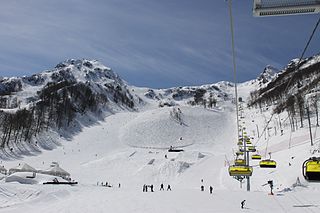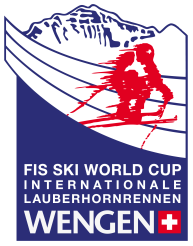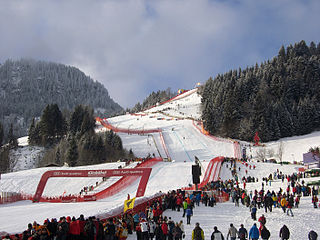Course sections
Starthang & Oberkurve
Starting slope ("Starthang") and Upper curve ("Oberhang") are rather flat parts with long gliding curves leading into the "Russisprung". It requires excellent acceleration and gliding abilities.
Russisprung
In 1988 Russi jump ("Russisprung") was constructed and named by Bernhard Russi at 2,180 m (7,152 ft) (AA). At first meant for test jumps only, but race director Fredy Fuchs insisted to integrated in the race.
The jump leads into flat terrain and ideally goes around 40 to 50 meters and past a snowmaking systems reservoir.
Traversenschuss
Traverse shot ("Traversenschuss") at 2,120 m (6,955 ft) (AA) interspersed with slight curves and two cross-country waves. The speed here increases from 100 to over 130 km/h.
Traverse
At 2,100 m (6,890 ft) (AA) a sharp left curve forms the transition to the traverse, in which the terrain slopes to the right. After 40 seconds, the first intermediate time is measured. The start of the combined event is in this section.
Panoramakurve
At 2,000 m (6,562 ft) (AA) the Panorama Curve ("Panoramakurve") was built to reduce the speed in front of the delicate "Hundschopf" passage. The long right turn got its name from the monumental view on the Eiger, Mönch and Jungfrau.
Hundschopf
At 1,975 m (6,480 ft) (AA) there is the "Hundschopf", most famous and the steepest part of the course at 42° degrees (90%) incline, a famous jump between rocks and safety nets and famous Wengen sign in the snow surface.
After S-curve where speed is reduced skier simply over jump the steepest part about 15 metres long. The short fall area and the slope that immediately turns to the left make the place even more difficult.
Russi describes it as followes: “In the smallest of spaces, everything comes into play that is required of a downhill driver. The curves in front of it are narrower than usual, between the rocks on the left and the safety net on the right are a maximum of 5 meters, the edge of the jump can only be guessed at, the choice of lines is shaped by the closure of the net and the driver's imagination. And then the bottomless! "
Canadian Corner
At 1,915 m (6,283 ft) (AA), right after jump and left turn, there is Minsch Ridge ("Minsch-Kante"), named after Swiss skier Josef Minsch who crashed on this exact spot heavily in 1965. It is a smaller jump, but very difficultis approached in a left movement and left in a right movement - the rider has to momentarily change the inner ski, so to speak, on the edge of the jump. Russi describes the position as an "ingenious combination of jump, curve and choice of line".
Minsch-Kante
At 1,890 m (6,201 ft) (AA), there is a "Canadian Corner", the strongly turning curve at the left-sloping transition into the "Alpweg", named after the Crazy Canucks, as Dave Irwin and Ken Read crashed here in 1976.
The Girmschbiel hill on the opposite side of the small valley has been a fan stadium in the middle of the route thanks to its location right next to the Wengernalp train station. Over 10,000 visitors watch the race on the hill and in the bars and VIP zones temporarily set up there - only here do they have a direct view of the famous key points such as "Hundschopf", "Minsch-Kante" and "Canadian Corner".
Alpweg
At 1,860 m (6,102 ft) (AA), the Alpweg is another fast glider. The section is only three meters wide connecting the upper and lower part of the descent in the middle of the steep slope in the Hasenbachtal, secured with safety nets on the left in the 1990s.
Kernen-S / Brüggli-S
At 1,825 m (5,988 ft) (AA), at first called "Brüggli-S" and renamed to "Kernen-S" after Swiss skier Bruno Kernen in 2007, who stayed uninjured while thrown backwards into the nets and back onto the course in a high arc in 1997.
This very close combination of a right and a left curve leads over a short bridge. Due to the high entry speed of 100 km/h, the skier has to drift in order to reduce the speed and find the most technically sophisticated line possible without losing too much speed. Quite a few skiers are driven a little bit up the opposite slope on the exit. Some of the world's best downhill skiers such as Karl Molitor, Jean-Claude Killy, Toni Sailer or Karl Schranz were eliminated at this technically difficult point. If the exit speed is too low here (at least 70 km/h is required), there is a risk of losing further time on the subsequent gliding passages. Bernard Russi called this turn as „the craziest chicane in the World Cup circus“.
Steilhang vor der Wasserstation
At 1,775 m (5,823 ft) (AA) right after a short jump, there is a steep slope before entering Water station ("Wasserstation"), which is too short to pick up speed again if this has been lost in the Kernen-S.
Wasserstation
At 1,770 m (5,807 ft) (AA) there is a Water Station ("Wasserstation"). Here the route leads through a short and narrow tunnel under the tracks of the Wengernalp Railway. The tunnel is only nine meters wide, although the passable area is much narrower due to the vaulted ceiling, the snow and the safety upholstery. After the tunnel, the route is unusually uphill for a few meters. This point is unique in the World Cup and is therefore one of the distinguishing features of the Lauberhorn route.
Langentrejen
Langentrejen was straight route in 1950s, there are now curves like in a Super-G. The route section has no key points and is also relatively unspectacular in terms of landscape, which is why it is partially omitted for television broadcasts. Nevertheless, this passage can be decisive for the race, as the driver with the wrong material or insufficient gliding and aerodynamic skills can lose the race. Mental conduct also plays a role, as the driver has time to reflect on his previous race on the long, rather flat passage.
Hanneggschuss
At 1,590 m (5,217 ft) (AA) there is a "Hanneggschuss", the fastest section in the World Cup circuit with average speed close to 150 km/h and the highest speed in WC history set here in 2013, when Frenc skier Johan Clarey reached 161.9 km/h (100.6 mph). It is approached via a left curve. The upper part of the steep slope is a little flatter than the lower part - the terrain transition can be "pushed" like a wave, or jumped like an edge. The pace is so fast here that the skis only have contact with the ground every 10 meters. The compression at the foot of the steep slope must be mastered with particular sensitivity. [2] [3]
Seilersboden
At 1,470 m (4,823 ft) (AA) there is "Seilersboden", the very flat section of the course, a long left-right combination leads to the Silberhornsprung.
Russi said: “A brief moment of calm. Here, on this little flat piece, breathing can return to normal. After the “crescendo” in the Hanegg Schuss, you have to switch to a fine pressure and tempo feeling in the flat left curve.
Silberhornsprung
At 1,450 m (4,757 ft) (AA), after this passage, it goes over the Silverhorn jump ("Silberhornsprung"), which was newly built in 2003. The jump was laid out in such a way that the silver horn can be seen in the camera position of the television broadcasts along with the jumping racers in the background. The difficulty here is the choice of line when approaching, as the jump is in the middle of a right turn.
Wegscheide
At 1,420 m (4,659 ft) (AA) there is "Wegscheide", the passage in the forest that is characterized by bumpy curves.
Österreicher Loch
At 1,395 m (4,577 ft) (AA) there is "Österreicher Loch". It got its name in 1954 after the three Austrians Toni Sailer, Anderl Molterer and Walter Schuster fell at this point. The bumps that they threw off the slopes at that time have now been removed.
Ziel-S
At 1,385 m (4,544 ft) (AA) is Finish-S ("Ziel-S"). A sharp left curve followed by a bump leads to the last key point, the Ziel-S. At this point all other World Cup descents are long over and legs are burning.
The technically difficult, heavily turning, often icy and restless right-left combination at the end of the long descent demands a lot of strength from the racers and often determines the outcome of the race.
Zielschuss
At 1,325 m (4,347 ft) (AA) is Finish Fall ("Zielschuss"), the second steepest part of the course, overjumped direct from "Ziel-S". The jump was flattened before the race in 2009 for safety reasons, and widened years before due to very narrow and consequently dangerous spot. Many skiers such as Peter Müller, Silvano Beltrametti, Adrien Duvillard and Bode Miller terribly crashed after 2.5 minutes of skiing being completely exhausted.
In 1991, on DH training just before the finish line, Austrian Gernot Reinstadler after jump and still being in the air flew direct to the safety net horribly crashed, died the next day. Safety measures have completely changed after this.
Ziel
At 1,287 m (4,222 ft) (AA) is a common Finish area ("Ziel") sharing it with "Männlichen" slalom course finish, with very short line for downhill skiers to stop before due to high speed and exhaustion.
Temporay grandstand and the permanent media center are built at the finish, which is about 1.2 kilometres away from center of the village.













































